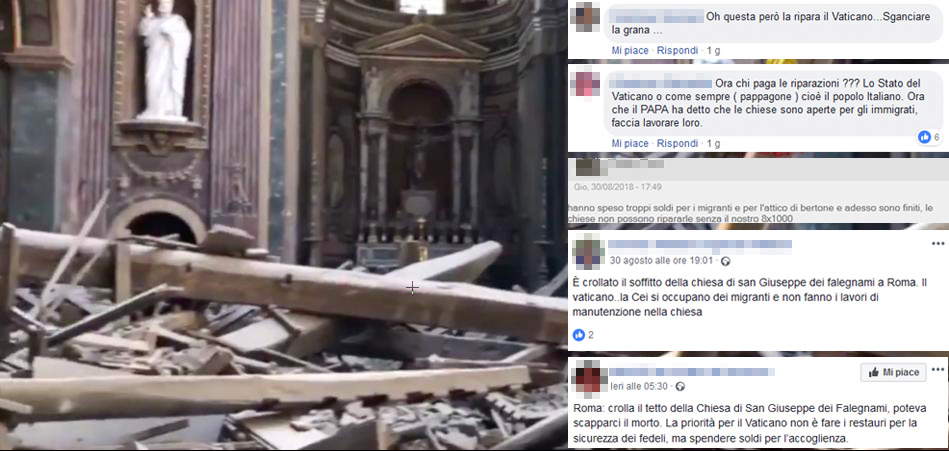St. Joseph of the Carpenters collapse: why it makes no sense to say "the Vatican will take care of it" (and blame... migrants!)
It is disheartening to note that populist bitterness has not spared misplaced comments even on the collapse of the precious ceiling of the church of San Giuseppe dei Falegnami in Rome. As if such a serious fact were an event that does not concern us, many, on social networks and on the online sites of various newspapers, wasted no time in ranting by throwing the issue on the mere economic level, wishing that the Vatican would provide the funds for the necessary restoration, and even going so far as to blame the collapse on migrants (since, dares the livorous Gentile to think, if one spends on reception one takes away resources from the maintenance of cultural heritage). Besides, it is known: the most boorish propaganda now blames migrants for every Italian evil, and it matters little if collapses and subsidence occur even in recently restored churches (as in the case of San Giuseppe dei Falegnami: a restoration had been conducted and finished in 2015, which will inevitably be investigated by the Public Prosecutor’s Office), or if problems even occur while restoration is in progress, as happened a few months ago in Naples. The important thing is to take the place of the competent technicians, the ministry staff, and even the judiciary, and within hours of the event to pass their judgment, sitting comfortably in front of a screen: collapse due to neglect, caused by the fact that the money for the restorations would be allocated to hospitality. An assumption so gross that it is frustrating to even have to comment on it. And what then should churches be, if not places where those in need are welcomed? A church, however beautiful it may be, that forgets its most important function, becomes nothing more than a dumb surrogate for a museum or art gallery.
 |
| Some comments on the collapse of San Giuseppe dei Falegnami found on social and newspaper sites |
No less insensitive, then, are those who are only concerned about the possibility of the Vatican taking over the restoration. They need to be given a piece of news: the church of San Giuseppe dei Falegnami is owned by the Vicariate of Rome, a subject that will presumably finance the restorations, as was already the case with the work carried out between 2012 and 2015, which was conducted partly with funding from the Italian Episcopal Conference, and partly with Italian public funding (in this case for more than 550,000 euros, against an expenditure of almost 750,000) allocated thanks to Lazio Regional Law No. 27 of 1990. As far as Church-owned buildings are concerned, in fact, every year quotas taken from the eight per thousand are made available by the Italian Episcopal Conference in order to conduct interventions to safeguard and enhance assets pertaining to the dioceses (cathedrals, parishes, abbeys, sanctuaries, seminaries). LR 27/90 also guarantees grants for interventions aimed at the recovery of buildings of worship that have historical, artistic or archaeological importance.
So, there is no need to worry: the Vatican will certainly do its part. But it is nevertheless very sensible that an Italian law also guarantees contributions for the restoration of church-owned buildings of worship that have significant historical, artistic or archaeological interest. And not only because these insist on Italian territory (and are therefore subject to Italian protection laws). But also and above all because these buildings are part of our history and constitute invaluable testimonies to our past and the historical events that have taken place over the centuries. Take just the case of the church of St. Joseph of the Carpenters: it is not just “the church of marriages,” as many newspapers have called it in the headlines, in an exceedingly hasty and reductive manner, almost bordering on humiliating. The church of St. Joseph of the Carpenters is of the highest historical importance because it is a living witness to that process of Christianization and appropriation of the sites of pagan Romans (in this case the Roman Forum) by Christians to which the vestiges of ancient Rome went. In fact, the church is located on the edge of the Roman Forum and insists directly above the Carcere Mamertino, where according to tradition Saints Peter and Paul were imprisoned, with all that this entails on a historical and symbolic level: and the relevance of these aspects acquires further value when one considers that San Giuseppe dei Falegnami is so called because it was the church of the Confraternity of Carpenters of Rome, which had it built in the late sixteenth century. So, this place of worship also tells a glimpse of the history of the guilds, of the history of labor, of the times when workers needed to gather in a church that also served the function of a gathering place and a living demonstration of the kind of environment (all the more sumptuous and magnificent the higher the resources available to the guilds) that the workers wanted to show to anyone passing through (think of the extraordinary case of the church of Santa Maria dell’Orto).
This is therefore why the collapse of the ceiling of the church of San Giuseppe dei Falegnami (a most valuable work) is not just a pure question of skills and resources. And not only the remains of Giovan Battista Montano’s ceiling remained under that rubble. Perhaps, there also remained a part of our attention and care for heritage, and a part of our openness to others.
Warning: the translation into English of the original Italian article was created using automatic tools. We undertake to review all articles, but we do not guarantee the total absence of inaccuracies in the translation due to the program. You can find the original by clicking on the ITA button. If you find any mistake,please contact us.





























